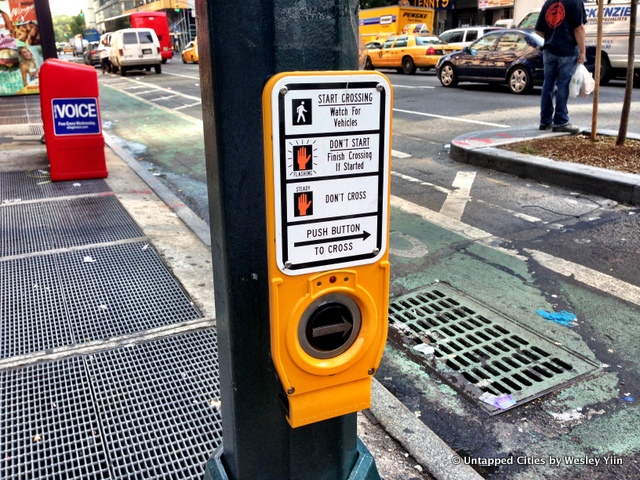 A crosswalk button in Midtown Manhattan
A crosswalk button in Midtown Manhattan
Any longtime New Yorker should be skeptical of crosswalk buttons. We’ve all been there, furiously jamming away at the button in a rush to cross the street, only to be halted for what seems like forever. There are few city-dwellers who still believe in the effectiveness of the buttons, although many still push them out of habit. The truth is that more than three-quarters of New York City’s crosswalk buttons are actually nonfunctional, according to Kate Ascher’s 2005 book The Works.
They did, however, once serve a purpose. The New York Times explained that, in 1964, when the button was first invented, city traffic was much lighter. Traffic lights for major roads would remain green until either a pedestrian pushed the button, or a car on the minor intersecting road was detected. After 90 seconds or so, the light would then change. As the city became more populous and reliant on automobiles, the button-pushing system became more and more inefficient until now, when it has been all but phased out.
So why doesn’t the city remove the archaic buttons to save pedestrians from confusion and embarrassment? Of course, the decision comes down to money. According to Ascher, the buttons each cost $400-$500 to remove, so if the city were to remove all 3,250 buttons, it would spending well over a million dollars. Thus, the buttons remain; as of 2005, only approximately 750 still worked.
Elsewhere, most experienced city-walkers have also dismissed the buttons as broken, or some sort of “placebo.” Still, there are other compelling theories of how they might operate. Some, for instance, claim that the buttons only work at certain times of the day. Reportedly, there are some cities with mostly functional crosswalk buttons, including Orlando, FL, and Victoria, British Columbia in Canada.
There’s some good reading on Quora regarding how the system works (when it’s functioning). If you have any information on crosswalk buttons that actually work, please do let us know!
Read more from our Cities 101 series about how stuff works in the city. Get in touch with the author @YiinYangYale.





